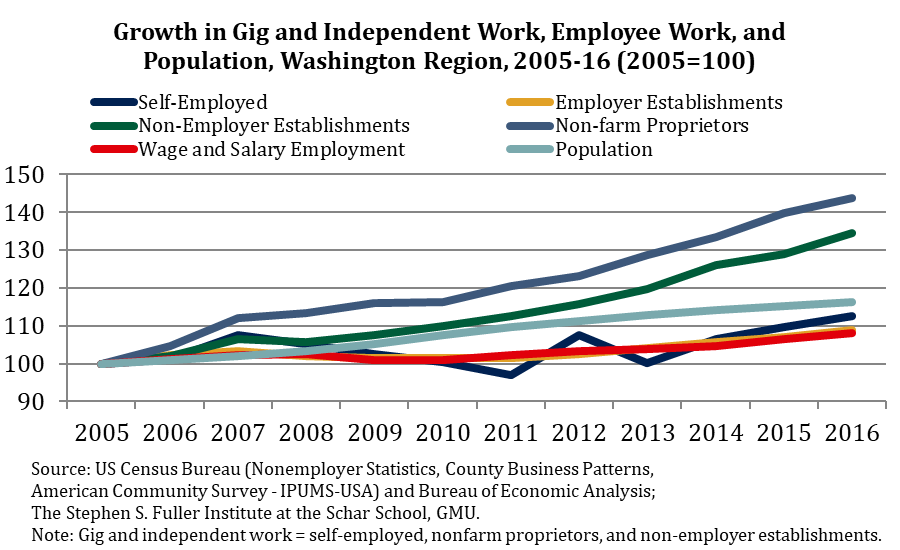By Ellen Harpel, President, Business Development Advisors
Download the full report as a PDF>>
The gig economy and independent work arrangements receive much national attention, but their role in regional economies is not well understood. In this report we describe national level research on the evolving ways work is performed and present several measures of gig and independent work in the Washington region.
Gig and independent work does not just refer to Uber drivers and other online platform workers, nor does it only mean the full-time self-employed. Gig and independent work includes a variety of full-time and part-time activities for earning income outside of an employer-employee relationship. It is often temporary or project-based, is mostly self-directed, and offers freedom and flexibility but also insecurity and unpredictability. Gig and independent work encompasses many types of people working in a variety of ways for different purposes.
Gig and independent work is a positive phenomenon for many individuals because it provides greater control, flexibility and income potential. For others, however, it reflects a necessity rather than a choice.

In the Washington region, gig and independent work plays a growing and important – but not driving – role in the economy.
- Approximately 10-15% of people in the workforce perform gig and independent work.
- Gig and independent work is growing faster than employer-based work.
- Most of the recent increase in gig and independent work appears to be in side businesses and activities that supplement income rather than primary jobs.
- An estimated 3-10% of total income or earnings in the Washington region is associated with gig and independent work.
- The total amount of income or earnings generated from gig and independent work has been increasing, but the average per worker has been declining. The level is well below average wage and salary earnings, again suggesting a growing level of supplemental rather than primary work.
- Gig and independent workers are found mainly in professional services (such as consultants), other services (typically personal services such as personal training or salon services), construction, real estate (brokers and agents), health care (doctors offices and home health care), and transportation. They also play a substantial role in the much smaller arts, entertainment and recreation sector.
- Gig and independent work matters most at low and high income levels. Middle-income earners are less likely to be gig and independent workers.
Takeaways
- Gig and independent workers are not a driving force in the regional economy, but they play an important supporting role in many of the region’s leading industries.
- More individuals are creating their own jobs or earning additional income through gig and independent work arrangements, which may make the regional economy less reliant on full-time employment than in the past.
- The downside is that the associated earnings are less secure and more unpredictable. Gig and independent workers are also less likely to have health insurance or a retirement account and are not covered by unemployment insurance. These factors matter less for work that is secondary or supplemental, but they are critical for those for whom gig and independent work is the primary source of income.
- Gig and independent work provides new opportunities for work and earnings, especially for individuals who face barriers to full-time employment or are seeking to balance work with lifestyle, school or family commitments.
- Compared to other regions, more people in the Washington region appear to be engaged in gig and independent work as a choice – either as a career preference or to supplement income – than as an economic necessity.
- At the same time, gig and independent work is an important source of earnings for low-income groups in the Washington region, and more research should be done to determine if it is a beneficial supplement, reflects poor access to quality jobs, or both.
- Establishments of all types (including small businesses and government) are using gig and independent workers more frequently to supplement their wage and salary workforce. This trend will likely continue. Washington’s demographics and specialized professional economy suggest there will be growing supply of and demand for gig and independent workers.
- Increasing numbers of individuals will find themselves engaged in gig and independent work at some point – or points – in their careers. Preparing for independent work is becoming a career imperative.
